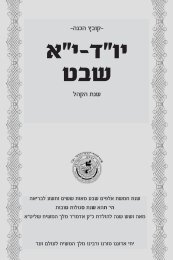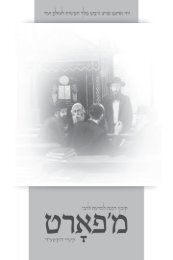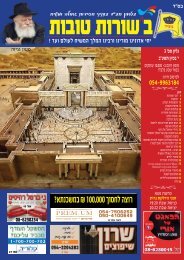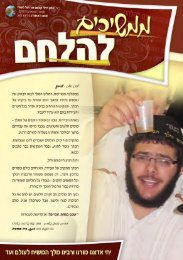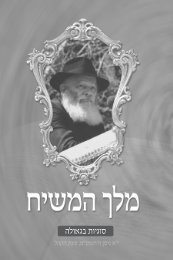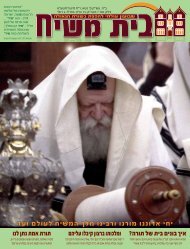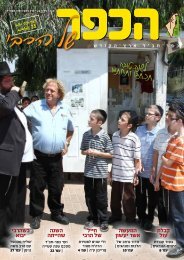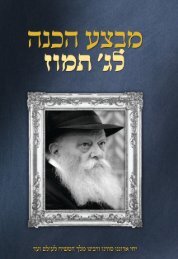You also want an ePaper? Increase the reach of your titles
YUMPU automatically turns print PDFs into web optimized ePapers that Google loves.
RAVDOVBERPINSONKADDISH
THEMYSTERYOFKADDISHUnderstandingtheMourner’sKaddishbyRavDovBerPinson
2This booklet on the Mourner’s Kaddish was preparedin honor and in memory of my dear Mother,Rochel Bas Avraham,for the day of her sh’loshim,the 11 th day of Teves which is the tenth month of the year.Teves contains the word tov, ‘good’.Ten’ is the number of kedusha which sweetens the paradigm of ‘eleven’—and this is also the power of Kaddish.The day of the Petirah was onaryzd elqk a''i glyie 't 'c meiWhich has the same Gematriya or ‘numerical value’ as her namedxye mdxa` za lgxWith deep gratitude,Rav DovBer PinsonRosh Yeshivah IYYUNIYYUN: Center for Jewish Spiritualitywww.IYYUN.com
5WHY KADDISH?Reciting Kaddish is a universal practice done to honor or merit a person who has passedon. We might ask why this prayer is singled out as so important. There are certainly manyother powerful ways to commemorate and honor the beloved deceased:• There are many sources that speak of the great soul-elevation accomplishedthrough giving charity in honor of a deceased person. [1]• Some sources speak about building a mausoleum. [2]• Erecting a gravestone or monument creates a seat for the makifim ortranscendent levels of the person’s soul. In the Gemara, the headstone is referredto as the nefesh, since this level of soul permeates it. [3]• One should study Torah in honor of the deceased. [4]• One should recite the Haftara in the merit of a deceased parent. [5]• Lighting a candle during the Shiva period creates joy for the soul. In general,souls receive pleasure when we light candles in their memory. There is anestablished custom to light a candle every year on the date of a person’spassing. [6]Yet, Kaddish stands out among all these forms of commemoration. Why? Furthermore,what do the ancient Aramaic words of Kaddish really mean to express? Lamentation forthe dead? Comfort for the living? A declaration of faith in Hashem in the face of difficultlosses?Kaddish speaks of exalting the “Great Name” of Hashem, our Creator. What does thishave to do with commemorating the departed? Why pray to exalt the Great Name whensomeone dies? How might this bring solace to the living, or assistance for the soul of thedeparted?
6If Kaddish is meant to help the living reaffirm their belief in Divine justice, then perhapsit should say, “I humbly accept upon myself the judgment of Hashem.” From the wordingof the Kaddish it seems rather that it is more a statement of continuation anddetermination; despite their loss, the living pledge that they will continue their beloved’swork in sanctifying Hashem’s name in this world.Before we begin exploring the Kaddish in more depth, let us clarify that there are variousforms of Kaddish, the primary ones being the Chatzi Kaddish or ‘Half Kaddish’ and theKaddish Shaleim, or ‘Full Kaddish’. During the actual prayers, we most frequently usethe Half Kaddish, which marks a transition within the daily prayer service. Another formis the Kaddish d’Rabbanan, the ‘Kaddish of the Sages’, which is recited after a group ofpeople has studied Torah. The version we are discussing is ‘Mourner’s Kaddish’,otherwise known as Kaddish Yasom, literally, the ‘Orphan’s Kaddish’.A HISTORICAL PERSPECTIVEThe core of the Kaddish prayer dates back to the period after the destruction of the firstTemple, and was established by the Members of the Great Assembly (Aruch HaShulchan,55:1). It was composed in Aramaic, the ancient language that all the Jews spoke duringthe period after the destruction of the Temple, so that everyone could understand themeaning of the words (Tosefos on Berachos, 3a) including non-Jews (Kol Bo, 7). Thisshows that in our times, those hearing Kaddish, and certainly those reciting it, shouldlearn the meaning of the words.The oldest known version of the Mourner’s Kaddish is found in the oldest known prayerbook, the Siddur of Rav Amram Gaon of the 9 th Century, C.E. While it is clear thatKaddish has been a universal practice for hundreds of years, it is uncertain at what pointit became common practice to recite Kaddish for a person who passed on.The idea of saying a prayer to spiritually assist someone who passed on has a source inTanach: King David prayed for his late son, Avshalom (Sh’muel II, 19:1; Sotah, 10b). Astory in the Gemara mentions the importance of specifically reciting Kaddish for thedeceased: [9]
7Rabbi Akiva said that once he was walking on the road and encountered aman covered in coal dust, carrying a heavy load of wood that he hadcollected. Rabbi Akiva greeted him and inquired, “Are you a slave? If so,perhaps I can redeem you. Or, are you destitute? If so, I could give yousome money.” The man replied that he was neither a slave nor poor.“Rebbe, I am dead, not alive!”The man explained that this was part of his afterlife soul-journey; he neededto rectify and achieve a tikkun for actions done during his life, and he wasexperiencing the energy of harsh judgment.Rabbi Akiva asked him if his ‘supervisors’, as it were, had indicated anyway that he could be unburdened from this hardship. The man answered, “Iheard it said, that if I had a son who would stand amid the congregation andsay Kaddish, and if the congregation would respond, ‘May the Great Namebe blessed,’ I would be released from this suffering.”Rabbi Akiva asked him where he lived during his life. He went there andfound one of the man’s sons, circumcised him, taught him Torah, andeventually this person was able to say Kaddish and Barchu. The father wasthen released from his torment.Later on, this man came to Rabbi Akiva in a dream and said that he was nowin Gan Eden.We can see from this story that the principle of Kaddish is that “A child can bring meritto a parent” (Sanhedrin, 104a). On a deeper level, parents and children share a commonsoul-root within the great, primordial soul of Adam—our actions below have an impact inHeaven and an impact upon other souls that are connected to us. Thus, over time, itbecame a common custom for one to recite Kaddish for deceased parents—to help, ifneeded, expedite their journeys into Gan Eden (Rama, Siman 376:6).
8JOURNEY TO THE GARDEN OF EDENEventually, all souls get to Gan Eden. Any experience of torment along the way is notmeant as a ‘punishment’, rather as a sponge that soaks up all negativity, so that the soul,or the ‘memory’, can survive in Gan Eden. [7]A bodiless soul can no longer achieve elevation. It has passed into a world of purespiritual being-ness, where there is no more opportunity for ‘doing’. At that point, onlyliving persons connected with this departed soul on the physical plane (which indicates aspiritual connection or common root-soul in higher planes), can help the departed gainspiritual movement.Kaddish, from this perspective, is a negation of negativity, a removal of torment, or away of helping a soul who is stuck. The Arizal teaches that there is also a positive reasonfor reciting Kaddish. It is to help souls ascend into higher, deeper levels of Gan Eden:“The purpose of Kaddish is not only to assist a soul in gaining release from the judgmentof Gehenom, as is commonly believed, it is also to assist a soul that is already within GanEden to rise higher and higher” (Sha’ar HaKavannos, Derush Kaddish). Therefore,Kaddish is beneficial even to tzadikim.Kaddish is also beneficial to the living who recite it; the activity of exalting andsanctifying the Name is a healing practice. Reciting Kaddish among other mourners helpscreate fellowship where each person helps the others mitigate feelings of loneliness orhopelessness. In the face of despair, we create a small community of healing andrecommitting ourselves to sanctifying Hashem’s name.INTERPRETATIONS WITHIN THE TEXT OF KADDISHYisgadal v’yiskadash shmeih rabbah‘May the Great name be exalted and sanctified’
9Kaddish begins with the words Yisgadal v’yiskadash shmeih raba, ‘May the Great Namebe exalted and sanctified.’ What ‘Great Name’ is this, and why is it not already exalted?Why pray to exalt the Great Name when someone dies? How might this bring solace tothe living, or assistance for the soul of the departed?One simple, inner meaning of the phrase shmeih raba or ‘the Great Name’, is ‘the DivineName that creates everything’; raba, ‘great’, has the same letters as Bara, ‘Creator’.When a death—a concealing of life—is experienced, the Creator’s Name is alsoconcealed from perception (Avudraham). One inner meaning of the word mevarach(from baruch) is ‘reveal’. Therefore, when we say Y’hei sh’mei rabba mevarach…, weare saying, ‘May the Name of the Creator be revealed, forever, and for all eternity.’We are the ‘limbs of the Shechina’ (Magid of Mezritch). The pain we suffer here, below,causes the Divine Presence to ‘experience pain’ as well: Imo Anochi b’tzarah, ‘I am withhim in suffering.’ When we are in exile, the Shechinah is in exile (Megilah, 29a). Sinceour soul is a part of Hashem, the agony that the soul experiences in galus or ‘exile’—physical and spiritual limitation—also causes a type of galus or confinement for thePresence of Hashem on earth. “The human soul is Hashem’s candle” (Mishlei, 20:27).When there is a diminishing of “Hashem’s candle” on earth, there is a lessening of Divineenergy, so to speak, within Creation. When a person passes on, he takes away part ofHashem’s light in the world, and thus Hashem’s presence is felt less.This may be illustrated by a scenario in 16 th Century Europe, when suicide began to bewidely outlawed. The taking of ones life was seen as an offence against the local king;death meant one less subject, and this diminished the king’s grandeur. Similarly, everyhuman being is made in the Divine image, and everyone is precious. Imagine a coinbearing the image of the king. If the coin were to be lost, the ‘image’ of the king wouldbe diminished in the world. When a person passes on, Hashem’s image is less apparent inthis world.
10Kaddish, which we would expect to mention the deceased and the journey of thedeceased’s soul in the afterlife, instead speaks only of the Creator’s glory. Since whenone person leaves this world there is one less player in the orchestra of the Master of theUniverse, we therefore sanctify and glorify Hashem’s name; we affirm and replenishHashem’s Presence in the world through the mitzvah of Kaddish. Thus, the function ofKaddish is to comfort the Divine Presence, as it were.This is also why we recite Kaddish in Aramaic, a ‘secular language’. [8] Speaking a moreworldly language helps us draw down Hashem’s Presence into our mundane world, andinto a world of separation, death, and pain. The Divine Presence in the world becomeswhole again.The word kaddish has a numerical value of 414: Kuf (100), Dalet (4), Yud (10), Shin(300). This number is two times 207, and 207 is the value of the word ohr, ‘light’.‘Double light’ alludes to the simultaneous presence of the Ohr Yashar, ‘Direct Light’,explicit or apparent light and joy, and the Ohr Chozer, ‘Reflected Light’, light thatemerges from within darkness or sadness. By means of Kaddish, we pray that we shouldhave both forms of light: we should have the light that emerges out of our mourningprocess, ‘Reflected Light’—but from now on, we should have only direct, revealed lightin our lives.In the experience of the death of a loved one, there is a muting of the divine energy orlight in one’s life. Some people begin to focus on painful questions such as, ‘Why did thishappen? What was the divine purpose in it? Why me? Why now?’ It seems there are noanswers, and nothing to say. Because this muting is an organic part of the mourningprocess, mourners are advised: Ha’anek dom, ‘remain silent’ (Moed Katan, 15a). Sincethey are, during this time, ‘separate from the light’, they are like a silent, empty ‘vessel’.A mourner is considered an ilem, a ‘mute’ person.The Divine name Elokim alludes to constriction and limitation, such as is experienced ina condition of mourning. The letters in Elokim can spell out the phrase ilem Yud-Hei, ‘the
11Yud-Hei is muted’ or the supernal Light of Yud-Hei is not visible. In other words, in afull grieving process, there is a separation between the higher part of the name of Hashem(Yud-Hei) and the lower part (Vav-Hei). The numerical value of Vav (6) and Hei (5) is11. When Vav-Hei falls away from Yud-Hei, and becomes isolated, the energy of‘eleven’ stands out—eleven being associated with kelipa, ‘covering’ or husk ofconcealment. When Vav-Hei is covered with kelipa, the Light of Yud-Hei abovebecomes obscured from perception.The number ten represents wholeness or perfection. There are ten sefiros or vesselsdesigned to receive the One Light. When the vessels receive the Light and allow it tounify with them, the result is ten luminous sefiros. When the Light is not allowed to unifywith the vessels, the light and vessels retain their separate identities and there is one Lightplus ten vessels, adding up to eleven separate elements. The energy of Divine Light isthen muted and cannot express itself directly in the world. Kelipa results.On a practical level, kelipa implies negativity, because negativity seems to conceal thepositive nature of the Infinite Light. When we experience something as positive,whatever it may be, while we may not recognize it consciously, we are filled with light,joy, meaning or purpose. Conversely, when confronted with tragedy or death, weexperience darkness, a concealing of light and joy. When we are suffering, we may notsense the reason or wisdom behind the events in our lives.Every experience has both a ‘light’ and a ‘vessel’: the experience itself is the vessel,whereas its meaning or purpose is the light. A vessel without light is kelipa.In our daily lives, we are capable of both ‘kelipa-perception’ and ‘non-kelipa perception’.At times, we perceive the Light or the ‘Hand of the Creator’ guiding us; at other times allwe can perceive is the apparently random, external dimension of life, a vessel without theLight of the Divine Presence.
12The meta-cause of death, separation and kelipa, is the fragmentation within the Name ofHashem, the split between the Vav-Hei and the Yud-Hei. When there is a division withinthis ‘source’, division and death manifest in the world.In our historical era, the Great Name, the Yud-Hei-Vav-Hei, is still generally divided bythe force called Amalek (Shemos, 17:16). Amalek represents the kelipa of spiritualcoldness, doubt, and the separation between the mind and heart. We pray that the DivineName should become complete and whole again (Machzor Vitri; See B’rachos, 3a,Tosefos, ad loc). However, our sages also say, “Hashem vowed that His Name…will notbe complete until Amalek’s name is totally obliterated" (Tanchuma, Ki Setzei, 11; Rashi,ibid). How is Amalek’s name, and his kelipa, wiped out?The words Yisgadal Ve’yiskadash contain eleven Hebrew letters and thus correspond tothe Vav-Hei (11). The letters of the word shmeih spell out Sheim Yud-Hei, ‘the DivineName Yud-Hei’. Yisgadal v’yiskadash shmeih raba therefore means that the Vav-Heishould be elevated to and reunited with the Yud-Hei; may the Divine energy isolated inthe lower realms rise, and become one with the Light of the Shmeih, the Name Yud-Hei.When they are in oneness, Yud-Hei and Vav-Hei will then be rabah, ‘great’ or complete.When the Vav-Hei is thus “elevated” and “sanctified”, the negative power of ‘eleven’,kelipa, or the influence of Amalek, is wiped out, and only the greater unity of the DivineName remains. The ‘vessel’ is integrated with the ‘light’; experience and meaning arealigned in our lives.[* Another, similar way of looking at this is that shmeih raba has seven letters, alluding to kedusha, ‘holiness’.Therefore, we’re praying that the Divine spark in Vav-Hei rise and become unified in its source in holiness, the Yudhei.]When this great alignment is activated, even when we experience emotional and spiritualcontraction, or the power of ‘Elokim’, that very experience becomes transparent to theYud-Hei. The condition of ‘ilem’ opens, and we can see through the events of our lives tothe Great Name. Then, even in our grief, we are one with the Light. This brings us deephealing, and it contributes to the healing of the entire world.
13The numerical value of the word shmeih, ‘Name’, is 345, the same as the value of E-lShad-dai, one of the seven sacred names of Hashem. On the other hand, 345 is alsoequivalent to the words elokim acheirim ‘foreign deities’ or forces of alienation. Whenwe observe the light of the sacred names of Hashem in everything, all forces of alienationand separation in the universe are nullified; the Shmeih becomes raba, ‘great’.Yisgadal v’yiskadash shmeih rabah: these four words correspond to the four letters in thename of Hashem: Yud, Hei, Vav and Hei. When we ‘fill’ these four letters with an Aleph,the sum of the letters is 10:Yud is spelled ‘Yud-Vav-Dalet’, which are 3 letters.Hei is spelled ‘Hei-Aleph’, which are 2 letters.Vav is spelled ‘Vav-Aleph-Vav’. which are 3 letters.Hei is spelled ‘Hei-Aleph’, which are 2 letters.3 + 2 + 3 + 2 = 10This is another illustration of the fact that when we create kedusha or ‘sanctification’, the‘number ten’ manifests, meaning the energy of completion and perfection. We are sealedfrom the influence of the number eleven—kelipa, separation, and negativity.…Be’alma di-v’ra chirusei;v’yamlich malchusei,v’yatzmach purkanei v’kareiv Meshichei…In the world that was created according to His will;May His Kingdom be established,May Redemption sprout forth, and may His Anointed One come soon.
14This passage contains ten words, again signifying the energy of completion. It alsoalludes to the Ten Utterances of Creation and the Ten Utterances of Revelation, as willshortly be explained.B’chayeichon, uv’yomeichon,uv’chayei d’chol Beis Yisrael,ba’agalah u’vizman kariv,v’imru, amein.May it happen in your lifetime, and in your days,and in the lifetime of all the House of Israel,speedily and very soon,and they should say, Amein.These words in the Kaddish, from “May it happen in your lifetime…” to “…Amein” forma distinct prayer in itself, and they not part of the flow of the actual Kaddish, as theAriZal points out. This is a prayer for world redemption to come—ba’agalah meaning‘suddenly’ (Rokeach), and u’vizman kariv meaning ‘swiftly’. The words “in yourlifetime” and “in your days” and “in the lifetime of all the house of Israel” areaffirmations of life, of continuity in the face of death. Since an end of life has beenexperienced, Kaddish allows the mourner to affirm life and continuity, many times eachday.Y’hei shmei rabba mevarach l’olam ul-almei almaya.May His great name be blessed forever and for all eternity.This sentence is the essence and focus of the entire Kaddish. It is an Aramaic translationof the Hebrew phrase Baruch sheim malchuso l’olam va’ed, ‘Blessed is the Name of HisKingdom, for ever and ever’ (Targum Yerushalmi, Devarim, 6:4). It is also related to averse in Yechezkel: “I will exalt and sanctify Myself” (38:23). This latter verse comes
15from a chapter about the battle of Gog and Magog and the future time when “Hashem’sName will be One” (Siddur of Rabbi Yaakov Emden, M’B, Siman 56:2).The Gemara says that when we recite Amein, Y’hei shmei rabah…, the Holy One, as itwere, nods his head and says: “…And what is there for a father who distances hischildren? And woe to the children who have been exiled from the table of their father”(Berachos, 3a). In other words, the recitation of Kaddish causes Hashem’s compassion tobe stirred for us. Hashem wants to bring all of us back together, around His great ‘table’.“When we say Amein, Y’hei shmeih raba… with all our koach or ‘strength’, and withintention and raised volume (Rashi, Tosefos, Shabbos, 119b), all negative decrees areannulled, and the gates of Gan Eden are opened” (ibid).The word y’hei is spelled Yud-Hei-Aleph. These are the three letters that can formalternate spellings (‘fillings’) of Hei (in other words, Hei can be spelled Hei-Yud, Hei-Hei, or Hei-Aleph). With the different numerical values resulting from these spellings,the Name of Hashem, Yud-Hei-Vav-Hei, can be ‘filled’ in multiple ways, with differentsums: 72, 63, 45, and 52. These numbers, in Hebrew, are four mystical Divine Names,AV (72), SaG (63) MaH (45) and BaN (52), together representing the ultimate fullness ofHashem’s Name. Therefore, Amein, y’hei shmei raba means, ‘Let it be that the y’hei—the “ultimate filling” of the Shmei—be raba, complete.’When this fullness is complete, the raba, the ‘greatness’ of the Name, becomes aceaseless, uninterrupted flow, like a be’er, a ‘well’, (raba and be’er have the sameletters). When the ultimate fullness of the Name is revealed, it manifests as a source ofabundance of blessings and life.The sentence, ‘Y’hei shmei raba mevarach l’olam ul-almei almaya’ has seven words and28 letters, corresponding to the seven words and 28 letters of the first verse in the Torah,“In the beginning, Elokim created….” The seven words of ‘Y’hei shmei…’ alsocorrespond to the seven planetary influences and the seven days of the week. The Beis
16Yosef says that the Hebrew names of the seven planetary influences (Shabtai or ‘Saturn’,Maadim or ‘Mars’, and so forth) together contain 28 letters (Orach Chaim, Siman 56).The 28 letters also correspond to the days of the month. The first verse in the Torah(Bereishis, 1:1) has seven words, corresponding to the seven days of the week, and it hastwenty-eight letters, corresponding to the days of the month (Da’as Z’kenim). This samepattern can be found with the words of revelation in the opening verse of the TenCommandments, “And G-d spoke all these words, saying” (Shemos, 20:1); here again,there are seven words and twenty-eight letters. Thus, when we say “Y’hei shmei…” weare praying that all these diverse influences in Creation, including the divisions andchanges within the flow of time, should be permeated by the revealed Divine Presence.In TaNaCh, the number 28 represents ‘change’. The book of Koheles (3:2-8) speaks oftwenty-eight seasons, in which ‘there is a time for everything’: “There is a time to bejoyous and a time to mourn, a time to speak and a time to be quiet, etc.”Change corresponds to a sense of separation and disunity. Thus, when we recite “Y’heishmeih…,” we are healing all the change and disunity in the world, and unifying it in theGreat Name of Hashem. A such, Kaddish helps heals the dramatic changes involved inour separation from our beloved departed.The number 28, written in Hebrew letters, spells the word koach, ‘strength’. This alludesto the advice of the Gemara, quoted above, that we are to recite “Y’hei shmeih…” with allour koach.When Moshe went up to Heaven to receive the Torah, Hashem asked him, “Is there noShalom from where you are coming?” This meant, ‘Do you come from a place wherepeople do not greet each other upon meeting?’ Moshe responded, “Does a servant evergreet his master?” Hashem told him “You should have helped Me. Tell me I shall besuccessful.” Then Moshe said, “So may the koach of Hashem be increased, as You havesaid” (Shabbos 89a; Rashi, ad loc). Again, the word koach, 28, alludes to Kaddish.
17Therefore, Hashem was thus asking Moshe to say Kaddish, in order to increase thestrength of the Divine Presence in the world, so-to-speak. Our recitation of Kaddish also‘gives strength’ to Hashem.…L’olam u-l’almei almaya…Forever and for all eternityEach of the three words in the phrase l’olam u-l’almei almaya, hint to the term olam,‘world’. The three ‘worlds’ here refer the world of celestial spheres, the world of angelsand the world of humans. They could also be seen as the three worlds of B’riah or‘Creation’, Y’tzirah or ‘Formation’, and Assiyah or ‘Completion’, or the three realms ofpersonal experience—mental, emotional and practical. When we say l’olam u-l’almeialmaya, we are drawing down the unity of Hashem into to all of these ‘worlds’. We assertthat the ‘Great Name’ should be unified with every realm, and thus we should have directperception of this unity within all dimensions of experience.Yisborach, v’yisromam…b’rich HuThis next paragraph says: ‘May the name of the Holy One, blessed be He, be blessed,lauded, beautified, exalted, raised up, glorified, elevated and praised….’ There are eightverbs mentioned: 1) blessed, 2) lauded, 3) beautified, 4) exalted, 5) raised up, 6) glorified,7) elevated, 8) and praised. In the beginning of Kaddish are two verbs, “May His greatname be 1) exalted, 2) and sanctified.” In total there are 10 verbs, and they correspond tothe Ten Expressions of the Creation of the World, such as, “Let there be light.” TheseTen Expressions are the outer manifestations of a deeper spiritual vibration, the Aseresha-Dibros, the ‘Ten Utterances’ (often called ‘the Ten Commandments’) through whichthe Torah was revealed to the world.Just as the verbs of Kaddish are grouped into a set of two and a set of eight, the TenUtterances are subdivided into two groups: the first two that were heard by the wholecommunity, and the latter eight that were channeled through Moshe. This correspondenceshows that reciting Kaddish reveals the Unity of Hashem to the world, like the revelation
18of the Torah. Divine revelation creates a unity within the world as well, gently healing allthe fragmentation, grief, separation, alienation, and loneliness that exist within themourner.In Kaddish, there are seven words beginning with the letter Vav, from V’yishtabach,v’yispa’er, v’yishalal: 1) and lauded 2) and beautified…7) and praised. Vav is thenumber six, and 7 x 6 = 42. Also, each of these seven words contains six letters, andagain, 7 x 6 = 42. When we left our slavery in Egypt, it took us 42 journeys of variouslengths (as elaborated in the Torah portion of Maasei), before we were able to reach ourfull freedom and enter the Promised Land.The etymological root of the Hebrew word for Egypt, Mitzrayim, is metzar,‘constriction’. The 42 Journeys, according to the Baal Shem Tov, represent the 42 stagesa person traverses in life toward his or her internal freedom and divine destiny. Allmovement, growth, elevation and internal healing demand 42 basic stages. This isreflected as well in the Kaddish. As the 42 Journeys represent the movements require tobridge one reality to the next, Kaddish is the bridge to healing after one has experienced‘separation’ by means of a loved one’s death. Kaddish helps the mourner journey from aplace of ‘desert’, chaos and emptiness, toward his personal Promised Land within.In summary, to recite Kaddish is to reveal the Unity of Hashem and the unity of allCreation, to leave one’s a place of constriction, and journey toward healing andShalom—‘wholeness’ and peace.Oseh Shalom…He Who makes peace…The numeric value of shalom is 380: Shin (300), Lamed (30), Vav (6), Mem (40), plus4 for the four letters themselves, equal 380. Shalom is actually a Divine Name whichis the product of the Name Havayah “knocking on” the Name Ado-noi. [10] In other
19words, when the four letters of Havayah are placed above the four letters of Ado-noi,and multiplied vertically, they equal 380:Yud (10) Hei (5) Vav (6) Hei (5)Aleph (1) Dalet (4) Nun (50) Yud (10)10 x 1 = 10 5 x 4 = 20 6 x 50 = 300 5 x 10 = 5010 + 20 + 300 + 50 = 380Real peace is when Havayah is “healed”—when there is absolute unity betweenHavayah, the inner reality of Hashem’s Name, and Ado-noi, the outer expression ofthat Name.Ado-noi is the vessel for Havayah. Today, when we are praying, we pronounce thename Havayah as Ado-noi. However, although we pronounce it this way, and in doingso we have the intention to express the meaning of the name Ado-noi, we also have theintention to express the meaning of Havayah. We have both names in mind, and thuswe unite them to produce shalom.Havayah represents the aspect of Hashem’s infinity, formlessness and endlessness.Ado-noi represents the Hashem’s Presence revealed within nature; Ano-noi means the‘Master’—the Master of nature, the realm of form and limitation. While Havayah isHashem’s perfect Unity, Ado-noi is Hashem’s dominion over all imperfection andmultiplicity, all vessels and bodies. Shalom is the unity of these two oppositeparadigms.The shalom that we are speaking of is not a ‘phenomenon’ or ‘thing’ in any ordinarysense. It’s not even a blessing that emanates from Hashem. Rather it is Hashem, as itwere; Shalom is a Name of Hashem (Shabbos, 10b). When we pray that Hashemshould make shalom upon us, we are therefore asking that Hashem give us Himself.The Priestly Blessing in the Torah says, “May Hashem…establish for you
20Shalom…and (thus) place My Name upon the children of Israel…” (Bamidbar, 6:26-27).AmeinIn the Kaddish, we repeatedly say Amein. What does this word really mean? Thecommon meaning is, ‘May it be true,’ or ‘so be it.’ The Talmudic sage, Rabbi Chanina,says the meaning of amein is in the acronym that it forms: Keil Melech Ne’eman,‘Hashem is a faithful king’ (Shabbos 119a). The word Amein comes from the wordEmunah, ‘faith’, and Emes, ‘truth’. Amein is therefore a declaration of faith and truth: ‘Ihave faith in this; I know it is true.’ However, amein is also related to the word umnas,‘craft’ or ‘trade’. This teaches us that generating authentic spiritual faith and convictionrequires skill and labor.Amein has the same numerical value (91) as the word malach, ‘angel’. Every time werecite Amein we create holy angels, meaning, holy, positive vibrations. Amein isessentially a part of the blessing itself, and therefore when responding Amein, one shouldhave in mind the person who said the blessing (Rama, Siman 167:2). We send positive,healing energy to the mourner when we say Amein to the recitation of Kaddish.The numerical value of the word amein is 91: Aleph (1), Mem (40), Nun (50). Thenumber 91 corresponds to two primary names, or manifestations, of Hashem. The valueof the name Havayah, or the Tetragrammaton, is 26, and the Name Ado-noi is 65. Whenthese two Names are united, together they equal 91 (Me’iri, Shabbos 119b).The actual Tetragrammaton, symbolized here with the word Havayah, is ineffable—itspronunciation or vibration is ‘concealed’ or beyond our grasp. That is why, in prayer,when we look at the printed letters of Havayah, we only pronounce the ‘revealed’ name,“Ado-noi”. As we mentioned above, this verbal replacement creates a combination of thetwo names, a unification between the ‘concealed’, and the ‘revealed’. Havayah signifiesthe Divine Being above, while Ado-noi, indicates the revelation and manifestation of that
21Being in the lower realms. By answering Amein, one brings down the blessing, thatrevelation from above, into the world. Therefore, “a person who answers Amein is greaterthan the one who says the blessing” (Nazir, 66b). The numerical value of the word Ameinis also 91: Aleph (1), Mem (40), Nun (50). When we answer Amein, we unify the upperand lower Divine Names.Because of the value of 91, Amein also alludes to the Yud-Hei:The spelling or ‘filling’ of the letter Yud is: Yud (10), Vav (6), Dalet (4) = 20. Asmentioned earlier, the spelling of the letter Hei can take three forms:Hei (5), Yud (10) = 15Hei (5), Aleph (1) = 6Hei (5), Hei (5) = 10.Therefore, there are three possible numerical values for the ‘filling’ of the Yud-Hei:20 + 15 = 3520 + 6 = 2620 + 10 = 30When we add these three values together (35 + 26 + 30) we get a final sum of 91.‘Exalting the Great Name’ means to bring the higher Light of Yud-Hei into its ultimatefullness (91), and reveal it within the ‘muted’ vessels of Elokim. This is the same processas uniting Havayah and Ado-noi (91). We can now understand that reciting Ameinencapsulates the entire mystical purpose and function of Kaddish.May the fallen ‘eleven’ of the Vav-Hei, and all fragmentation in life, be lifted into itsproper unity with the Yud-Hei, thus making the Great Name complete. May this healingpermeate all of creation, permanently removing all pain and grief from the entire world.
22May we merit to observe the Oneness of Hashem with our own eyes, “speedily and verysoon”, with the revealing of Mashiach, Amein.
23____________________________________________________Notes:[1] There are many sources that speak of the great soul-elevation accomplished through givingcharity in honor of a deceased person. Midrash, Rabbeinu Bachya, on Devarim, 21:8. Beis Yosef, OrachChaim, 284; 621. Bach, ad loc; Tanchumah, Hazinu; Kaftor U’Perach, 44; Ramah, 621:4; Yoreh Deah,249:16; Kav HaYashar, 86.[2] Some sources speak about building a mausoleum. Yerushalmi, Shekalim, 2, 5; SeferHaChasidim, 738.[3] Erecting a gravestone or monument creates a seat for the makifim or transcendent levels of theperson’s soul. Likutei Torah AriZal, Parshas VaYechi, p. 118; Mishnas Chassidim, Meseches GemilusChassadim, 3:13; Reb DovBer of Chabad: Maamor Hishtatchus, 2. In the Gemara, the headstone is referredto as Nefesh, as the soul permeates its space. Rabbi Pinchas of Koritz, Aimrei Pinchas, Likutim, 41, p. 223.[4] One should study Torah in honor of the deceased. Yevamos, 122a, Rashi, in the name of theGaonim.[5] One should recite the Haftara in the merit of a deceased parent. Rama, Siman 376:6.[6] Lighting a candle during the shiva period creates joy for the soul. Ma’avar Yavok, Ma’amar 2,Chapter 15, p. 220. In general, souls receive pleasure when we light candles in their memory. RabbeinuBachya, Shemos, 25:31; Teshuvas Torah Lishmah, Siman 520. There is an established custom to light acandle every year on the date of a person’s passing. Maharshal, Siman 46; Magen Avraham, Siman 261:6;Nachalas Shiva, Siman 73; Mishnah Berurah, Hilchos Shabbas, 261:16.[7] Gehenom is experienced for, at most, twelve months. Mishnah, Ediyos, 2:10, and this is whenthe entire year unfolds and no zodiac influence can find merit for the soul. Tagmulei HaNefesh 11, p.31a;Shabbos, 33b; Zohar 1, p.107b. Some sources say that some souls must remain in gehenom for a longertime. Rosh Hashanah, 17a; Baba Metzia, 58b; Zohar II, p.150b; Zohar III, p. 220b. However, after theirextended period of cleansing, they too will enter Gan Eden. Midrash Talpiyos, Os 8, p.670. Gehenom isviewed as a sponge, which removes negativity Emek HaMelech, Shar Tikkunei Ha’Teshuvah, 1, p.15b.This is also the purpose of teshuvah Baba Metziah 58b, Tosefos; Rosh Hashanah, 17a. After an appropriatecleansing process, souls enter Gan Eden. Midrash Rabbah, Shemos, 7;4. Psikta Rabbati, 53:2. Ultimately,Gehenom itself (the experience of one’s own negativity) will become null and rendered obsolete, and allsouls will transcend the need for it. Asarah Maamoros, Maamor Chikur Din, p.302. Emek HaMelech, SharTikkunei HaTeshuvah, 3, p.17.[8] Kaddish is recited in Aramaic, the ancient language that all the Jews spoke during the periodafter the destruction of the Temple, so that everyone could understand. Tosefos, Berachos, 3a. Kol Bo, 7.Shibolei HaLeket, Siman 8. And that the Angels could not understand. Tur, Siman, 58, so there will be noKitrug/ negative adversary. Bach, ad loc.[9] The Gemara also mentions, in a story, the importance of praying for the deceased, andspecifically reciting the Kaddish. Kallah Rabsi, 2; Midrash Tanchumah, Noach; Ohr Zaruah, 2:50.[10] The Name Shalom is the Yud-Hei-Vav-Hei “knocking on” Ado-noi. Agra D’Pirka,Remez 22.
iyyunpublishing





